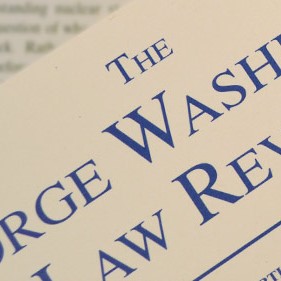Alexandra D. Lahav · April 2008
76 GEO. WASH. L. REV. 576 (2008)
This Article presents a third argument for collective justice based on democratic participation values. It urges that we re-envision the tort trial as a democratic enterprise rather than only an individual’s day in court. This argument draws an analogy to the theory of deliberative democracy, which values participation as a means of encouraging public deliberation and believes that contentious issues are best addressed through deliberative processes. Holding public trials and allowing juries to determine outcomes constitutes a deliberative process in which reasoned arguments are presented to citizens who participate in decisionmaking.
Although the dichotomy between autonomy and efficiency values remains the bedrock of mass torts scholarship, trial judges have been using a procedure that embodies this democratic justification: the bellwether trial. A “bellwether” is a sheep that leads a flock, around whose neck a bell is hung. In a bellwether trial procedure, a random sample of cases large enough to yield reliable results is tried to a jury. A judge, jury, or participating lawyers use the resulting verdicts as a basis for resolving the remaining cases. Judges currently use bellwether trials informally in mass tort litigation to assist in valuing cases and to encourage settlement. Instituted as a formal procedure, bellwether trials offer an innovative way to achieve collective justice in mass tort cases because they realize the democratic policies animating the jury right and the aims of the substantive law. These trials promote a type of “group typical” justice that is at once participatory and collective.
The Article begins with a description of bellwether trials using three examples: litigation arising out of the tragedy of September 11th, asbestos litigation, and a human rights class action against Ferdinand Marcos, former dictator of the Philippines. These case studies illustrate the reason that courts have developed innovative procedures such as bellwether trials to deal with mass tort litigation and provide some possible permutations of the procedure. They offer insights into the political economy of litigation that results in statistical adjudication and prompt us to think more deeply about the group typical justice that these trials promote.
Part II presents the policy arguments in favor of bellwether trials. Bellwether trials both realize the policies behind the right to a jury trial and the aims of the substantive law that procedures are meant to enforce. This Part begins by demonstrating that the jury right is a democratic, communal right. The jury serves two central political functions. First, it provides a democratic decisionmaking body, made up of ordinary citizens, for determining difficult questions to which there is no generally agreed upon answer. For example, juries lend legitimacy to the social process of monetizing injury. Second, the jury system provides some measure of protection against systemic bias that judges may exhibit. The bellwether trial promotes both of these functions.
Part III presents and refutes objections to bellwether trial procedures. These objections fall into three categories: distributional, autonomy-based, and Seventh Amendment objections. Distributional objections concern the difficulty of determining the variables about which inferences are to be made, of accurately awarding compensation based on statistical analysis, and of fairly distributing compensation among plaintiffs. Autonomy-based objections also form the root of due process concerns raised by group typical justice. These objections contend that bellwether trials violate a process-based right to individual participation. A final constitutional objection to the procedure is that bellwether trials violate the right to a jury trial in civil cases. Each of these objections deserves serious consideration, but none are fatal to formalizing bellwether trial procedures.
The fourth and final Part proposes a model constitutional bellwether trial procedure.

